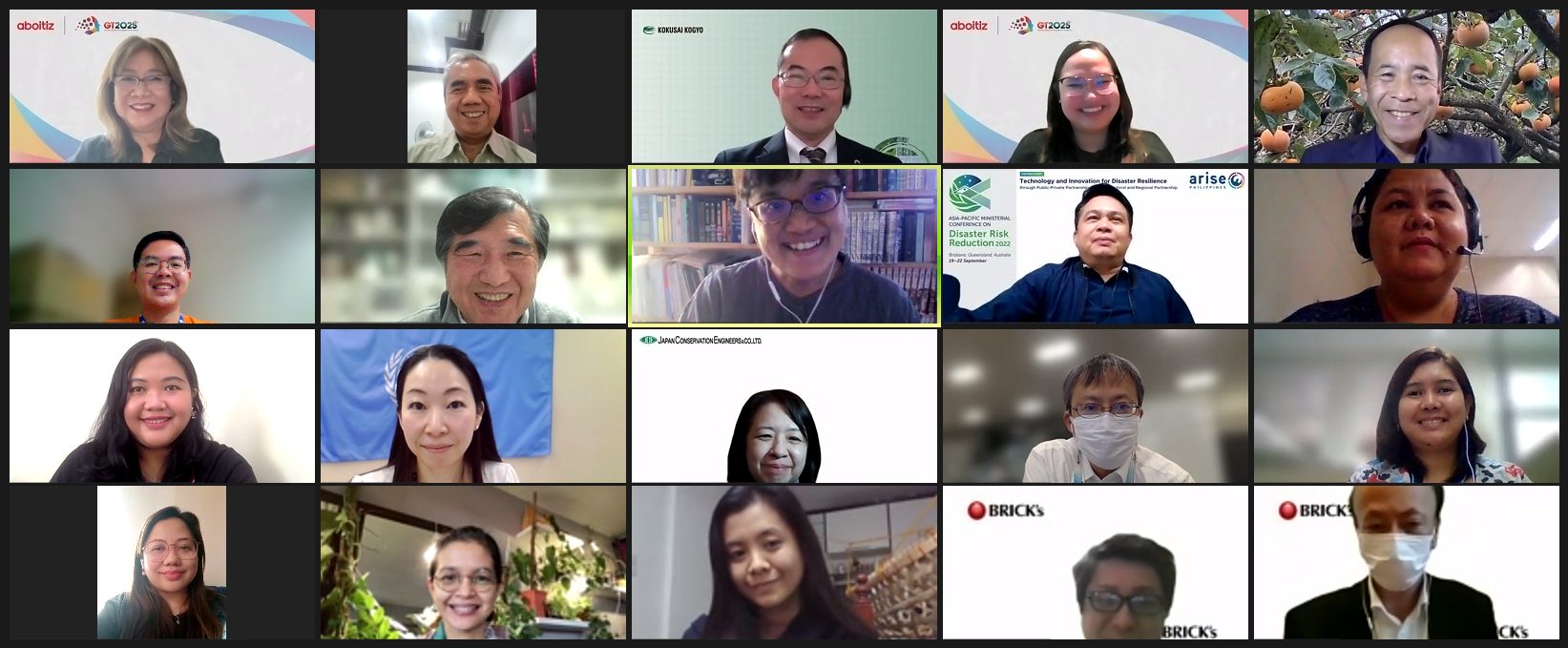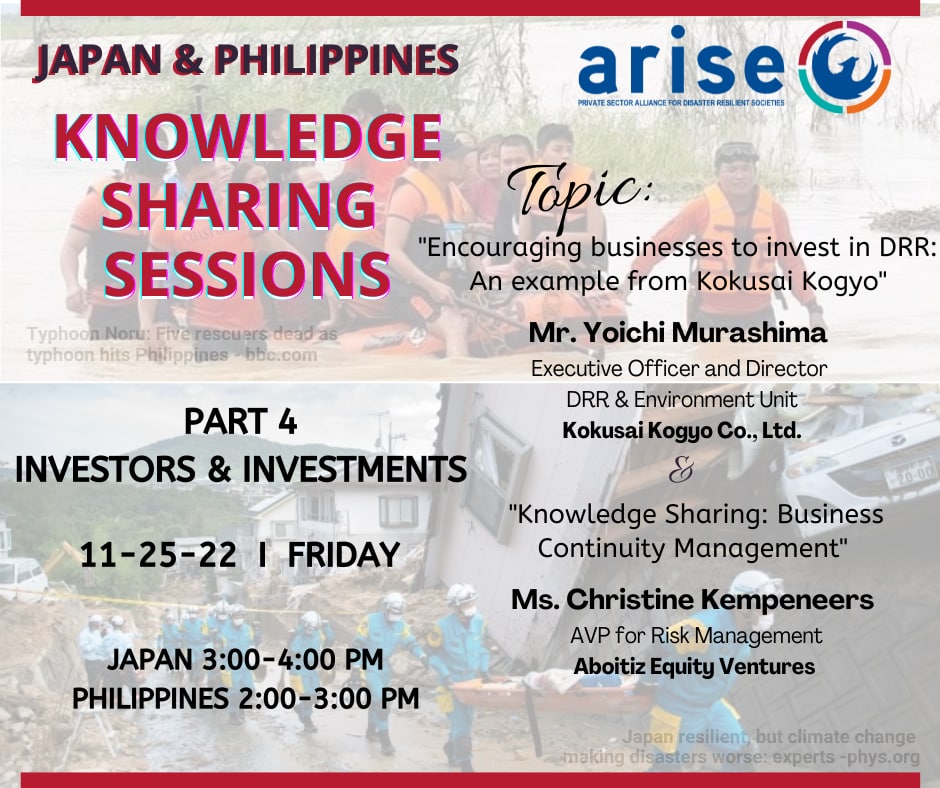
ARISE Japan and ARISE Philippines hosted their fourth Knowledge Sharing Session (KSS) on 25 November2022.
In his opening remarks, Mr. Masato Takamatsu, President of Tourism Resilience Japan and ARISE Japan Lead welcomed everyone to the fourth and final session in the KSS series covering the fourth ARISE Priority Area, Investors and Investment, following previous sessions on SMEs, Resilient Infrastructure, and Insurance. “So, are we all done? Definitely not” he said, and expressed hopes of the KSS becoming a foundation for future collaborative activities among ARISE Networks in Asia.
Ms. Yuki Matsuoka, Head, UNDRR Kobe Office followed with a briefing of the Sendai Framework Voluntary Commitments (VCs), where ARISE members and networks have now submitted over 10% (15 VCs) of the total commitments currently registered (more details in this report). Especially members of ARISE Philippines are active and have successfully published total 8 VCs so far. She welcomed the strong track record of VC implementation by the private sector, and particularly called for more VCs related to the Priority 3 (investment in DRR for resilience) of the Sendai Framework.
The Aboitiz Foundation, the Lead of ARISE Philippines’ Priority Area 2 for Investors and Investments working group, delivered an information-packed icebreaker presentation. Ms. Maribeth Marasigan, President and COO of the Aboitiz Foundation gave a short introduction outlining some of their strategic initiatives in building a sustainable and resilient enterprise. Aboitiz is a 100-plus-year-old Filipino conglomerate known for their strong commitment to good corporate governance and being active in energy, finance, agribusiness and food, real estate, infrastructure, and, more recently, data science. “We are promoting a data-driven culture and moving forward after five generations to become the country’s first “techglomerate,” as well as a truly sustainable enterprise,” noted Ms. Marasigan.
Ms. Christine Kempeneers, AVP for Risk Management, Aboitiz Equity Ventures then discussed how they drive change towards a better world by working with businesses and communities, by ensuring first of all that Aboitiz itself is resilient. “To continue to provide value to all stakeholders, not just investors, we must ensure we are built to last” said Ms. Kempeneers, describing an integrated and holistic resilience program that takes into account people, process, technology, and community, building up capacity to respond to risks as ‘muscle memory’ within the organization, integrating multiple management systems, extending to include partners and vendors.
As an example of such holistic management, Ms. Kempeneers described Aboitiz’s response to Covid-19 as well as Typhoon Odette, which were both anchored by business continuity plans but guided by strong communication with their people on the ground, consultations with subject matter experts and guided by daily hands-on management at the highest level. Ms. Kempeneers also noted how their longer-term strategy addressing climate concerns, TCFD disclosures, and their mindfulness of sustainability and ESG values affect not just their decision-making as investors, but also make Aboitiz attractive to investors themselves, as demonstrated by a direct loan from ADB and their issuance of a local currency climate bond tied to their geothermal power facility, which was a the first in Asia-Pacific in 2016. “We are living in a VUCA, or volatile, uncertain, complex and ambiguous world, and risk is a concern that keeps investors awake at night. At Aboitiz we are constantly looking at things from the viewpoint of both investors and investee” Ms. Kempeneers said.
Mr. Yoichi Murashima, Executive Officer and Director, Disaster Risk Reduction and Environment Unit, Kokusai Kogyo Co., Ltd. together with Ms. Yoshiko Abe, Kokusai Kogyo, then gave the second icebreaker presentation, focusing on how they encourage other businesses to invest in DRR. “The private sector invests in DRR, but they often don’t start investing until there is an absolute demonstrated need, in terms of social value or direct risk, so we encourage this investment through our product design as well as marketing” explained Ms. Abe on behalf of Mr. Murashima, describing their B to B tool for businesses to efficiently understand, utilize, and take action on risk information.
“What our system ultimately does, is reduce the heavy workload associated with disaster response, which is often concentrated on a few people” they explained, showing how larger companies managing a large number of locations across the country, such as hotels, construction sites, logistic hubs, or shops, utilize the map-based app’s customizable automated functions to contact suppliers and tenants in a less labor-intensive way, in order to take action toward better response and business continuity. “Businesses are already aware of their responsibility to protect their employees, serve their community, and to maintain business continuity, and they take action, but there are counter-currents that prevent businesses from taking that extra step. Our service encourages other businesses to consider proactively investing in DRR” said Ms. Abe, describing pricing and marketing aspects designed to encourage subscriptions at the operational level, so that the cost-benefits of investing in DRR could be demonstrated through an initial low-cost investment.
In the short discussion portion that followed, Mr. Takamatsu asked whether they are examples of how ROI on investment to disaster resilience were measured. Ms. Kempeneers, while acknowledging the challenge to put a number on ROI on this kind of investment, suggested as proxy the value of what is exposed to risk if the investment is not made. “While acknowledging the challenge to put a number on ROI on this kind of investment, the value of what is exposed to risk if the investment is not made. “That is a conversation we [need to have], what do we stand to lose? Usually what we stand to lose is beyond the risk appetite or risk tolerance of the organization [and reinforces the investment decision]”, Ms. Kempeneers said.
VAdm Alexander Pama, Co-Chair, ARISE Philippines asked how disaster information provided by private sector apps are coordinated with information provided by the government. Ms. Abe replied that, in the Japanese context, all disaster risk information and early warning originate from national or local government, and the private sector apps will build on this information, and thus never contradictory.
Ms. Abe commented on the apparently centralized nature of Aboitiz’s holistic management system, and asked whether such a system developed through lessons learned. Ms. Kempeneers noted that indeed it was the best configuration developed through experience, but not entirely centralized. “The model that really works for us is the Covid-19 response model, where individual businesses have their own response tailored to their requirements and operations; this varies at the operational level, but our efforts are concerted and aligned at the group level” she noted. Ms. Marasigan added that, in this arrangement, the group Foundation can take care of communities while allowing business units to focus on their business, and communities receive capacity building and assistance for prevention, mitigation, and also reconstruction, not just relief. Ms.
Ms. Joanna Rose Laddaran, UP ISSI asked about a BCP Training Program conducted among MSME third-party suppliers of Aboitiz, and the follow-up they received. Ms. Kempeneers replied that indeed there were several additional trainings conducted at intervals, and some of these MSMEs are included in their drills and exercises, so that their business continuity plans are aligned.
VAdm Alexander Pama, Co-Chair, ARISE Philippines warmly appreciated the informative presentations and the discussions that followed. “Disasters and climate risks are having significant effect on the costs of development, and this highlights the relationship between a country’s ability to manage climate risk and private sector investment” he said. He noted the need to acknowledge gaps that still exist in our appreciation of hazards and risks, and the critical role and importance of investing in innovations and utilizing science and technology. “This activity is not going to be the last engagement between our networks. We look forward to leveling up our activities, with the incoming participating of ARISE India” he concluded.
By: Ms. Yoshiko Abe, Kokusai Kogyo, ARISE Japan

